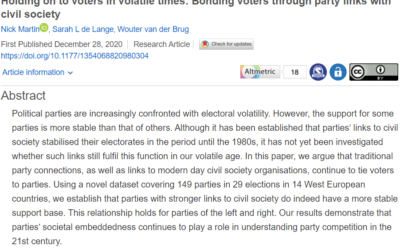The core argument of their book is a simple one. Competition in European democracies is between two types of party – dominant parties defined as those with recent government experience and challenger parties who do not have government experience but aspire to it. Premising their analysis on the growing fragmentation of the party system in Europe they identify three waves of challenger parties – a Social Democratic wave in the early 20th Century, a Green wave from the mid 1970’s, and a radical right wave in the last couple of decades. Successful challenger parties they argue are those who innovate by introducing new issues that divide a wedge within and between established parties, and by deploying anti-establishment rhetoric targeted at undermining the perceived competence of dominant parties.
One of the most intriguing stories in the book is the resilience of dominant parties in the face of challenger assault. With many conditions in their favour such as control over the levers and resources of government, dominant parties have a strong arsenal of strategic weaponry at their disposal. Dominant parties attempt to neutralize the threat from challengers by converging to the centre ground and forming ‘Grand’ coalitions, by avoiding issues favourable to challengers, and mobilising the reputation for competence that they have with electorates.
De Vries and Hobolt argue convincingly that a key determinant of the success or failure of challenger party strategies is the ‘appropriability’ of the issues they choose to innovate on. Appropriability captures the essence of issues, such as immigration and European integration, that do not fall easily onto a left-right dimension and have the potential to divide mainstream parties of the both the left and the right. The authors modelling of elections in 17 Western European countries suggests that attaching importance to the immigration issue increases the likelihood of voters choosing a challenger party by as much as 8 percentage points.
The authors demonstrate convincingly that all across Europe the ‘market power’ of dominant parties has retreated in the face of waves of challenger onslaught, but does their account amount to a convincing theory of political change? I suggest that there are three main limitations to their account.
First, adopting a binary account of party competition significantly oversimplifies party competition in contemporary Europe. One can think of at least two groups of parties who are neither dominant nor aspire to become so. Throughout Western Europe, for example, there are numerous parties whose aim is simplify to give voice to and ensure party representation for specific demographic groups. These are often but by no means only religious groups and the parties that represent them have shown remarkable resilience in the face of social change. And there are many niche parties, particularly on the radical left, who express the values of substantive sections of the electorate who they attempt to mobilise to constrain the freedom to act of dominant parties.
Second, there are weaknesses in the way the authors discuss strategic innovation and challenger parties. For example, there is no discussion of the way in which strategies of early-wave challenger parties are diffused and imitated by those who follow. Once the challenger playbook of new issues and anti-establishment rhetoric is deployed early in a wave, it would seem more appropriate to describe those who follow as imitators rather than innovators. De Vries and Hobolt’s argument would be stronger if they could show how later radical right wave challengers such as VOX in Spain or the Alternative fur Deutschland in Germany, built on and developed the strategies of early wavers such as the Front National in France.
A third and probably more serious weakness of the book is its political one-sidedness. The third wave of challenger parties is characterized solely as a radical right phenomenon. However, in the eleven general elections in Western Europe between April 2019 and February 2020, radical left parties secured over 12 million votes, outpolling parties of the radical right. The omission of radical left parties enables the authors to focus on the so-called cultural dimension of the challenger wave with issue innovation around hostility to immigration and European integration. The organization of challenges to dominant parties on the basis of opposition to the economic settlement of the ‘neoliberal’ period is elided from the analysis, as is the fact that radical right parties have tended to share many of tenets of this opposition, such as resistance to welfare cuts. Viewed through this frame dominant parties no longer have the votes to sustain themselves in office because as Jonathan Hopkin suggests ‘the share of the population benefitting from such arrangements has contracted’.
The consequence of this one-sided account is that rather than seeing the recent wave of challenger parties as a signal of the failure of democratic systems to meets citizens demands for restriction of the impact on their lives of unregulated markets, De Vries and Holbolt suggest that it is a threat to responsible government that requires ‘stability among a set of parties that can agree on a number of core policy issues’. For a polity to be truly democratic, however requires as Bartolini and Mair argued ‘a substantive electoral dynamic which can ensure the competitiveness of the system through the creation of potentially winning alternatives.’ Challenger parties should perhaps be seen more as contributors to the potential renewal of this electoral dynamic.
To attempt to construct a comprehensive theory of electoral change on the basis of a framework from another discipline is a brave endeavor and in many respects the authors succeed. Perhaps the clarity of argument that the authors achieve through their simplified model of party competition may come at the expense of a deeper substantive account of the trials and tribulations of European democracy, but this is a book that all students of party competition will find enriching.




